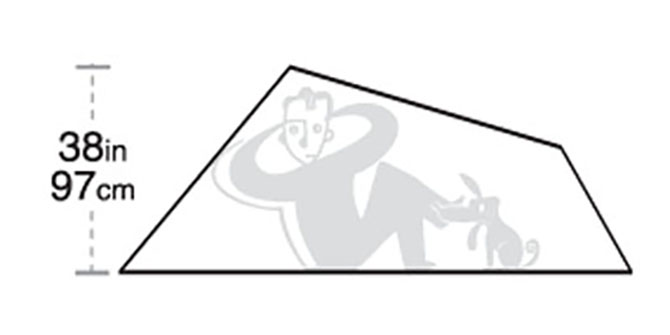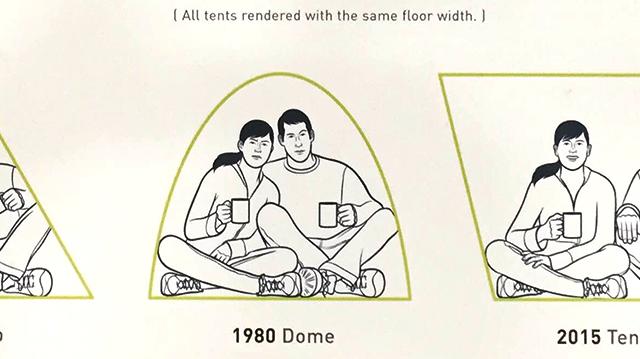The next generation of ultralight backpacking tents is adopting vertical walls and square shapes to maximise living space while shedding weight. Here’s how they work and what these new tents mean for your next camping trip.
What’s the matter with traditional tent shapes? Space and weight. The whole idea of a tent is to provide a liveable outdoors shelter that’s easily portable. And, you’ve typically had to choose between having one that’s light or one that’s spacious.
That ratio has improved over the years. Your dad’s A-frame tent weighed a ton and had virtually no room inside, particularly if you wanted to sit up or, god forbid, stand. The domes that replaced them did better, thanks to the advent of flexible poles. But, domes were still much wider at their floors than at their tops; if you wanted one with a big interior, it had to be oversized for your needs. Then came tubes, which are similar to domes but feature more elaborate shapes in an effort to maximise interior space. But, even the lightest tubes still require you to carry poles; however light those may be. To go lighter, we need to ditch the poles.
Where are we now? The lightest freestanding, mass-production tent currently available is the Big Agnes Fly Creek 2 Platinum. It weighs in at a scarcely believable 709g. The downsides? Thanks to drastically light materials, it’s very expensive at $US550 and, even though it claims to be a two-person, it was barely big enough for Wiley and I to sleep in. It also did a relatively poor job of keeping the weather off and was only tall enough that I could just about sit up partially right by the door.
For a few years, people wanting to save weight without breaking the bank have been turning to tarps. Those are people really dedicated to weight savings though. To provide shelter, a tarp must be pitched with 1) a perfect spot chosen to protect it from the wind, in which water will drain around the camper 2) the expertise to orient it effectively to stand up to rough weather and rig it appropriately for such and 3) the right surface or tie off points (trees, shrubs or rocks) to achieve adequate tension. And, unless you want to carry a separate shelter that hangs from a tarp’s underside, these don’t keep out bugs.
The rise in popularity in tarps has closely tracked that of trekking poles. Fans of those claim they’re able to use them to hike both faster and safer, particularly over tricky terrain. And, once you reach your campsite, they can double as support for your tarp. Or, now, your tent.
Can a trekking pole provide good tent support? Actually, yes. Typically made from carbon fibre and designed to support your body weight, these poles are enormously strong and can poke into the ground with real stability. All they require are some nicely tensioned guy lines and they can provide some substantial support.


The Big Agnes Fly Creek 2 Platinum (top) and Scout UL2 (bottom) weigh the same, but the latter has appreciably more liveable space inside.
Shapes, materials and optimised design. Trouble is, you only carry two trekking poles per-person. Early shelters designed for them simply swapped the trekking poles for a ridge pole, holding the centre of the shelter up. This saved weight — you didn’t have to carry tent poles — but did nothing for liveability.
Enter this new generation of shelter, designed from the ground up to work with trekking poles while maximising living space.

Sierra Designs’ new Tensegrity range cants the poles out an angle to maximise head room and includes a diminutive hoop pole for the foot of the tent, maximising liveable space inside. A substantial, sideless awning provides good room in which to store your gear or a little shelter to cook and hang out under if it’s raining. Despite weighing just 992g in its lightest two-person configuration, the Tensegrity range maximises liveability with three doors, ample ventilation, a surprising amount of space inside and good weather protection. We’re testing one right now.

Corey spent a few nights hunting in the High Sierra this fall while sleeping in the Big Agnes Super Scout UL2. It features a massive “garage” area for gear storage or bad weather hangs and ample room for two men to spoon each other, with an all-up weight of just 992g.
The similar, but garage-free Big Agnes Scout UL2 (pictured above) has even more living space inside, but by ditching the huge awning drops weight down to just 709g.

The not-yet-released, but much anticipated MSR Flylite weighs the same, but appears to have even more internal volume thanks to locating its two trekking poles at the door, then propping up the rear with a dinky little tent pole.
In addition to simply replacing the tent poles with trekking poles, all these examples also employ very thin, very light, but very strong materials and are now constructed differently from their predecessors. Where most current three-season tents are a double-layer design that carries a separate rainfly over the tent body — an arrangement that facilitates both ventilation and weatherproofness — these designs are single-layers; the body of these tents is also its outmost layer. Traditionally, such designs have been less ideal for most campers due to their lack of ventilation, but all these tents feature large mesh panels, now protected by eves — overhanging portions of the tent body designed to keep rain off.
On these shelters, single-layer appears to have become a simpler, more elegant solution. In addition to being both light and liveable, these shelters are also affordable. At least relative to that traditional Big Agnes Fly Creek Platinum. The Tensegrity range starts at $US320 and the Scout UL2 is just $US300.

And it’s not just ultralight backpacking tents that are benefiting from the cubic, single-layer approach. Nemo just announced a giant, family camping tent — the Wagontop — that has 198cm of headroom across nearly its entire ceiling. Not only will you be able to stand up and change more easily in such a design, but that height should help it ventilate unprecedentedly well in warm weather.
Picture: It’s a Sierra Designs marketing illustration for the Tensegrity, but I had trouble finding it online so pinched it from GearJunkie.
